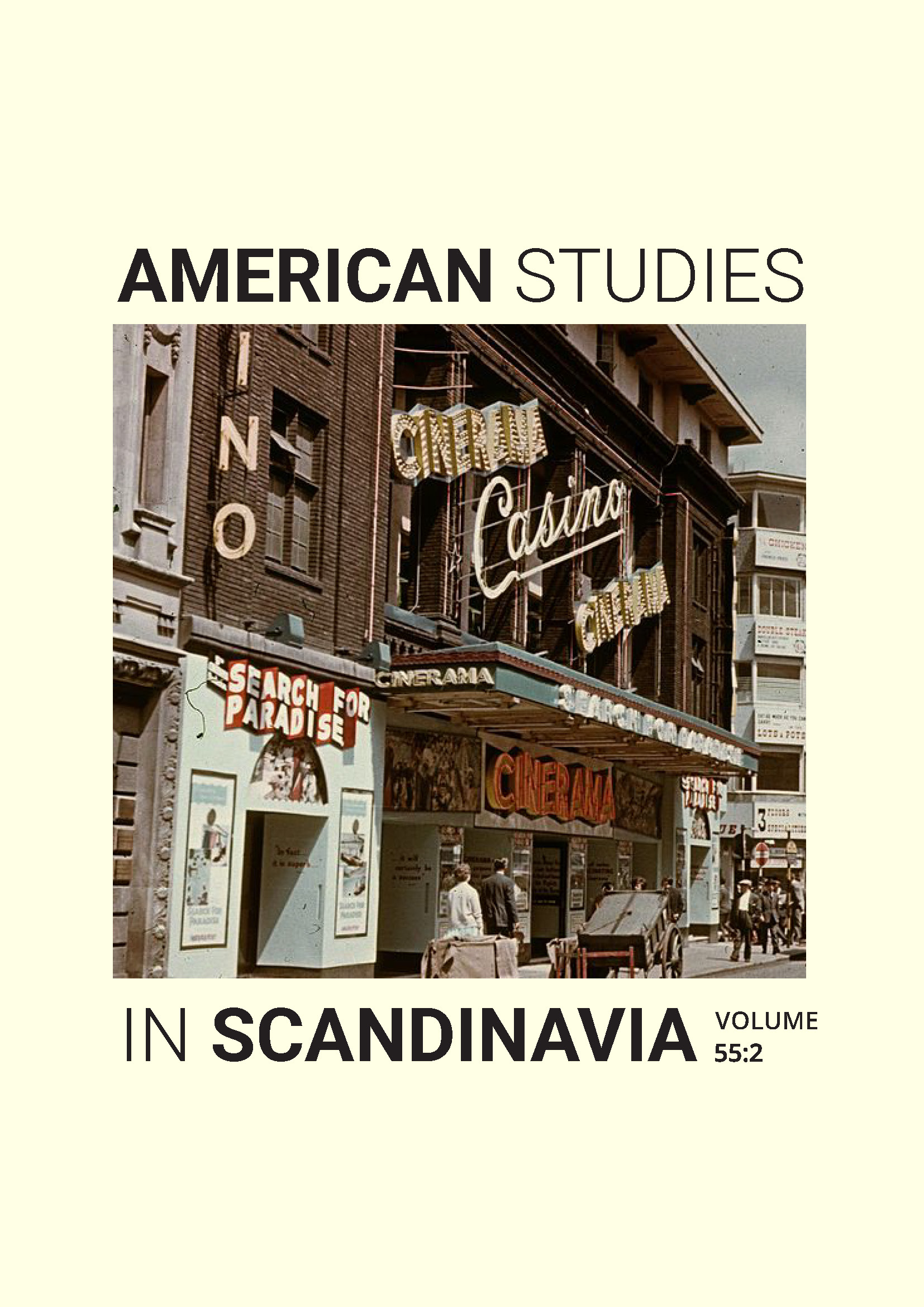The Dark Comedy of the Courtroom: Norman Jewison’s And Justice for All
DOI:
https://doi.org/10.22439/asca.v55i2.7042Keywords:
courtroom drama, And Justice for All, dark comedy, the system, heroic lawyerAbstract
This article examines And Justice for All’s (1979) peculiar spin on the courtroom drama. Though the film embraces a mode of seriousness to portray sexual violence and an unjust criminal justice system, it also includes an undercurrent of dark comedy and absurdity. The article shows how the film incorporates dark-comedic absurdity to emphasize how severely malfunctional the criminal justice system is. While the film reproduces the lawyer-as-hero trope known from earlier eras in American film history, it is very disillusioned with the state of the criminal justice system as such. In this sense, it gives viewers a recognizable lawyer-hero to root for even though the film invites viewers to be very skeptical of the state of the system.
References
Abrams, M. H. A Glossary of Literary Terms. 7th ed., London: Harcourt Brace College Publishers, 1999.
Asimow, Michael. “When Lawyers Were Heroes.” University of San Francisco Law Review 30.4 (1996): 1131–38. https://heinonline.org/HOL/P?h=hein.journals/usflr30&i=1145.
Baker, Phil. “Kurt Vonnegut.” The Guardian, 13 Apr. 2007, https://www.theguardian.com/books/2007/apr/13/usa.kurtvonnegut. Accessed 27 October 2023.
Belknap, Michal R. “The Warren Court and the Vietnam War: The Limits of Legal Liberalism.” Georgia Law Review 33.1 (1998): 65–154. https://heinonline.org/HOL/P?h=hein.journals/geolr33&i=83.
Bordwell, David. “Historical Poetics of Cinema.” The Cinematic Text: Methods and Approaches, edited by R. B. Palmer, Los Angeles, CA: AMS Press, 1989. 369–98.
Borstelmann, Thomas. The 1970s: A New Global History from Civil Rights to Economic Inequality. Princeton, NJ: Princeton University Press, 2012. https://doi.org/10.23943/princeton/9780691141565.001.0001.
Bridges, James, director. The China Syndrome. Columbia Pictures, 1979.
Broer, Lawrence R. Sanity Plea: Schizophrenia in the Novels of Kurt Vonnegut. Tuscaloosa, AL: The University of Alabama Press, 1989.
Coppola, Francis Ford, director. Apocalypse Now. United Artists, 1979.
Cowie, Jefferson. The Great Exception: The New Deal and the Limits of American Politics. Princeton, NJ: Princeton University Press, 2016. https://doi.org/10.2307/j.ctvc77hd3.
Demme, Jonathan, director. Philadelphia. TriStar Pictures, 1993.
Freese, Peter. “The Critical Reception of Kurt Vonnegut.” Literature Compass 9.1 (2012): 1–14. https://doi.org/10.1111/j.1741-4113.2011.00862.x.
Gehring, Wes D. American Dark Comedy: Beyond Satire. Westport, CT: Greenwood Press, 1996.
---. Genre-Busting Dark Comedies of the 1970s: Twelve American Films. Jefferson, NC: McFarland, 2016.
Haines, Errin. “The truths ‘To Kill a Mockingbird’ tells about white people.” The Washington Post, 22 July 2020, https://www.washingtonpost.com/lifestyle/2020/07/22/truths-kill- mockingbird-tells-about-white-people/. Accessed 27 October 2023.
Hale, Grace Elizabeth. A Nation of Outsiders. Oxford: Oxford University Press, 2011.
Haspel, Paul. “Arthur on a Quest in Baltimore Mythic Archetypes, Social Criticism, and Civic Self-Promotion in . . . And Justice for All.” Journal of Popular Film and Television 35.3 (2007): 127–32. https://doi.org/10.3200/JPFT.35.3.127-132.
Hill, George Roy, director. Slaughterhouse-Five. Cinema International Corporation, 1972.
James, Osamudia R. “Now We Can Finally Say Goodbye to the White Savior Myth of Atticus.” The New York Times, 15 July 2015, https://www.nytimes.com/roomfordebate/2015/07/15/how-should-schools-deal-with-the-new-atticus-finch/now-we-can-finally-say-goodbye-to-the-white-savior-myth-of-atticus. Accessed 27 October 2023.
Jensen, Mikkel. “The Wire and the Disenchantment of the Outsider.” American Studies in Scandinavia 51.1 (2019): 61–83. https://doi.org/10.22439/asca.v51i1.5791.
Jewison, Norman, director. And Justice for All. Columbia Pictures, 1979.
Klinkowitz, Jerome. “The Literary Career of Kurt Vonnegut, Jr.” Modern Fiction Studies 19.1 (1973): 57–67. https://www.jstor.org/stable/26279135.
Kruse, Kevin and Julian Zelizer. Fault Lines: A History of the United States Since 1974. New York, NY: W.W. Norton & Company, 2020.
Kubrick, Stanley, director. Dr. Strangelove. Columbia Pictures, 1964.
Kunze, Peter C. “For the Boys: Masculinity, Gray Comedy, and the Vietnam War in Slaughterhouse-Five.” Studies in American Humor 26 (2012): 41–57. https://doi.org/10.5325/studamerhumor.26.2012.0041.
Langkjær, Birger. Realismen i dansk film. Frederiksberg: Samfundslitteratur, 2012.
Levi, Ross D. The Celluloid Courtroom: A History of Legal Cinema. Westport, CT: Praeger, 2005.
Luketic, Robert, director. Legally Blonde. 20th Century Fox, 2001.
Lumet, Sidney, director. Network. United Artists, 1976.
Lynn, Jonathan, director. My Cousin Vinny. 20th Century Fox, 1992.
Mulligan, Robert, director. To Kill a Mockingbird. Universal Pictures, 1962.
Nichols, Mike, director. Catch-22. Paramount Pictures, 1970.
Papke, David Ray. “Law, Cinema, and Ideology: Hollywood Legal Films of the 1950s.” UCLA Law Review 48.6 (2001): 1473–93. https://scholarship.law.marquette.edu/facpub/275.
Pew Research Center. “Public Trust in Government: 1958-2021.” 21 May 2021, https://www.pewresearch.org/politics/2021/05/17/public-trust-in-government-1958-2021/. Accessed 27 October 2023.
Rafter, Nicole. Shots in the Mirror: Crime Films and Society. 2nd ed., Oxford: Oxford University Press, 2006. https://doi.org/10.1093/oso/9780195175059.001.0001.
Rosenberg, Norman. “Hollywood on Trials: Courts and Films, 1930-1960.” Law and History Review 12.2 (1994): 341–67. https://doi.org/10.2307/743746.
Rostron, Allen. “Mr. Carter Goes to Washington.” Journal of Popular Film and Television 25.2 (1997): 57–67. https://doi.org/10.1080/01956059709602751.
Shadyac, Tom, director. Liar Liar. Universal Pictures, 1997.
Siegel, Don, director. Dirty Harry. Warner Bros, 1971.
Silbey, Jessica. “Patterns of Courtroom Justice.” Journal of Law and Society 28.1 (2001): 97–116. https://doi.org/10.1111/1467-6478.00181.
Stiller, Ben, director. Tropic Thunder. DreamWorks Pictures, 2008.
Tomasulo, Frank P. “. . . Injustice for All: The Politics of Creativity in the Commercial Hollywood Cinema.” Creative Screenwriting 1 (1994): 51–57.
Travis III, Lawrence F. Introduction to Criminal Justice. 7th ed., London: Routledge, 2012.
Vonnegut, Kurt. Cat’s Cradle. 1963. Harmondsworth: Penguin Books, 1976.
---. Slaughterhouse-Five. 1969. London: Vintage, 2000.
Downloads
Published
How to Cite
Issue
Section
License

This work is licensed under a Creative Commons Attribution-NonCommercial-NoDerivatives 4.0 International License.



